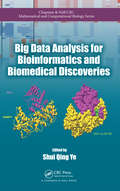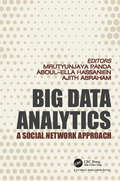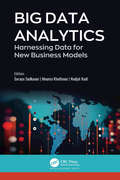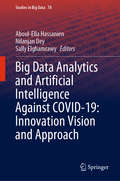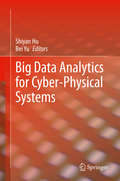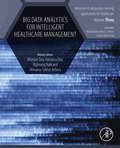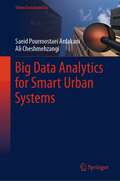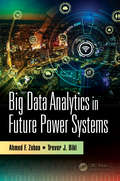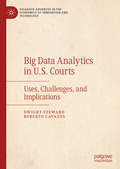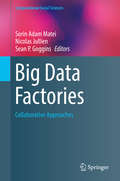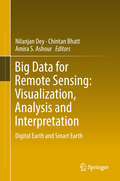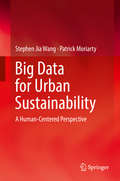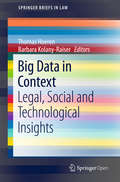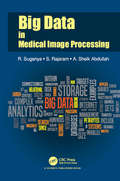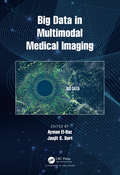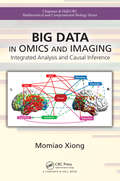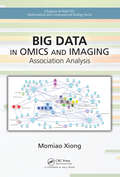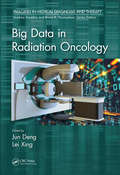- Table View
- List View
Big Data Analysis for Bioinformatics and Biomedical Discoveries (Chapman & Hall/CRC Computational Biology Series)
by Shui Qing YeDemystifies Biomedical and Biological Big Data AnalysesBig Data Analysis for Bioinformatics and Biomedical Discoveries provides a practical guide to the nuts and bolts of Big Data, enabling you to quickly and effectively harness the power of Big Data to make groundbreaking biological discoveries, carry out translational medical research, and implem
Big Data Analytics: A Social Network Approach
by Mrutyunjaya Panda Ajith Abraham Aboul Ella HassanienSocial networking has increased drastically in recent years, resulting in an increased amount of data being created daily. Furthermore, diversity of issues and complexity of the social networks pose a challenge in social network mining. Traditional algorithm software cannot deal with such complex and vast amounts of data, necessitating the development of novel analytic approaches and tools. This reference work deals with social network aspects of big data analytics. It covers theory, practices and challenges in social networking. The book spans numerous disciplines like neural networking, deep learning, artificial intelligence, visualization, e-learning in higher education, e-healthcare, security and intrusion detection.
Big Data Analytics: A Social Network Approach (Studies In Big Data Ser. #66)
by Mrutyunjaya Panda Aboul-Ella Hassanien Ajith AbrahamSocial networking has increased drastically in recent years, resulting in an increased amount of data being created daily. Furthermore, diversity of issues and complexity of the social networks pose a challenge in social network mining. Traditional algorithm software cannot deal with such complex and vast amounts of data, necessitating the development of novel analytic approaches and tools. This reference work deals with social network aspects of big data analytics. It covers theory, practices and challenges in social networking. The book spans numerous disciplines like neural networking, deep learning, artificial intelligence, visualization, e-learning in higher education, e-healthcare, security and intrusion detection.
Big Data Analytics: Harnessing Data for New Business Models
by Soraya SedkaouiThis volume explores the diverse applications of advanced tools and technologies of the emerging field of big data and their evidential value in business. It examines the role of analytics tools and methods of using big data in strengthening businesses to meet today’s information challenges and shows how businesses can adapt big data for effective businesses practices. This volume shows how big data and the use of data analytics is being effectively adopted more frequently, especially in companies that are looking for new methods to develop smarter capabilities and tackle challenges in dynamic processes. Many illustrative case studies are presented that highlight how companies in every sector are now focusing on harnessing data to create a new way of doing business.
Big Data Analytics: Harnessing Data for New Business Models
by Soraya Sedkaoui Mounia Khelfaoui Nadjat KadiThis volume explores the diverse applications of advanced tools and technologies of the emerging field of big data and their evidential value in business. It examines the role of analytics tools and methods of using big data in strengthening businesses to meet today’s information challenges and shows how businesses can adapt big data for effective businesses practices. This volume shows how big data and the use of data analytics is being effectively adopted more frequently, especially in companies that are looking for new methods to develop smarter capabilities and tackle challenges in dynamic processes. Many illustrative case studies are presented that highlight how companies in every sector are now focusing on harnessing data to create a new way of doing business.
Big Data Analytics and Artificial Intelligence Against COVID-19: Innovation Vision and Approach (Studies in Big Data #78)
by Aboul-Ella Hassanien Nilanjan Dey Sally ElghamrawyThis book includes research articles and expository papers on the applications of artificial intelligence and big data analytics to battle the pandemic. In the context of COVID-19, this book focuses on how big data analytic and artificial intelligence help fight COVID-19. The book is divided into four parts. The first part discusses the forecasting and visualization of the COVID-19 data. The second part describes applications of artificial intelligence in the COVID-19 diagnosis of chest X-Ray imaging. The third part discusses the insights of artificial intelligence to stop spread of COVID-19, while the last part presents deep learning and big data analytics which help fight the COVID-19.
Big Data Analytics for Cyber-Physical Systems
by Shiyan Hu Bei YuThis book highlights research and survey articles dedicated to big data techniques for cyber-physical system (CPS), which addresses the close interactions and feedback controls between cyber components and physical components. The book first discusses some fundamental big data problems and solutions in large scale distributed CPSs. The book then addresses the design and control challenges in multiple CPS domains such as vehicular system, smart city, smart building, and digital microfluidic biochips. This book also presents the recent advances and trends in the maritime simulation system and the flood defence system.
Big Data Analytics for Intelligent Healthcare Management (ISSN #Volume 3)
by Himansu Sekhar Behera Nilanjan Dey Himansu Das Bighnaraj NaikBig Data Analytics for Intelligent Healthcare Management covers both the theory and application of hardware platforms and architectures, the development of software methods, techniques and tools, applications and governance, and adoption strategies for the use of big data in healthcare and clinical research. The book provides the latest research findings on the use of big data analytics with statistical and machine learning techniques that analyze huge amounts of real-time healthcare data. Examines the methodology and requirements for development of big data architecture, big data modeling, big data as a service, big data analytics, and moreDiscusses big data applications for intelligent healthcare management, such as revenue management and pricing, predictive analytics/forecasting, big data integration for medical data, algorithms and techniques, etc.Covers the development of big data tools, such as data, web and text mining, data mining, optimization, machine learning, cloud in big data with Hadoop, big data in IoT, and more
Big Data Analytics for Smart Urban Systems (Urban Sustainability)
by Saeid Pourroostaei Ardakani Ali CheshmehzangiBig Data Analytics for Smart Urban Systems aims to introduce Big data solutions for urban sustainability smart applications, particularly for smart urban systems. It focuses on intelligent big data which takes the benefits of machine learning to analyse large and rapidly changing datasets in smart urban systems. The state-of-the-art Big data analytics applications are presented and discussed to highlight the feasibility of big data and machine learning solutions to enhance smart urban systems, smart operations, urban management, and urban governance. The key benefits of this book are, (1) to introduce the principles of machine learning-enabled big data analysis in smart urban systems, (2) to present the state-of-the-art data analysis solutions in smart management and operations, and (3) to understand the principles of big data analytics for smart cities and communities. Endorsements‘Over the many years of collaboration between academia and industry, we noticed the common language is ‘big data’; with that, we have developed novel ideas to bridge the gaps and help promote innovation, technologies, and science’.- Tian Tang, Independent Researcher, China ‘Big Data Analytics is a fascinating research area, particularly for cities and city transformations. This book is valuable to those who think vigorously and aim to act ahead’.- Li Xie, Independent Researcher, China‘For urban critiques, knowledge trains aspiring opportunities toward outstanding manifestations. Smartness has evolved or/ advanced rambunctious & embracing realities along (with) novel directions and nurturing integrated city knowledge’.- Aaron Golden, SELECT Consultants, UK
Big Data Analytics in Future Power Systems
by Ahmed F. Zobaa Trevor J. BihlPower systems are increasingly collecting large amounts of data due to the expansion of the Internet of Things into power grids. In a smart grids scenario, a huge number of intelligent devices will be connected with almost no human intervention characterizing a machine-to-machine scenario, which is one of the pillars of the Internet of Things. The book characterizes and evaluates how the emerging growth of data in communications networks applied to smart grids will impact the grid efficiency and reliability. Additionally, this book discusses the various security concerns that become manifest with Big Data and expanded communications in power grids. Provide a general description and definition of big data, which has been gaining significant attention in the research community. Introduces a comprehensive overview of big data optimization methods in power system. Reviews the communication devices used in critical infrastructure, especially power systems; security methods available to vet the identity of devices; and general security threats in CI networks. Presents applications in power systems, such as power flow and protection. Reviews electricity theft concerns and the wide variety of data-driven techniques and applications developed for electricity theft detection.
Big Data Analytics in Future Power Systems
by Ahmed F. Zobaa Trevor J. BihlPower systems are increasingly collecting large amounts of data due to the expansion of the Internet of Things into power grids. In a smart grids scenario, a huge number of intelligent devices will be connected with almost no human intervention characterizing a machine-to-machine scenario, which is one of the pillars of the Internet of Things. The book characterizes and evaluates how the emerging growth of data in communications networks applied to smart grids will impact the grid efficiency and reliability. Additionally, this book discusses the various security concerns that become manifest with Big Data and expanded communications in power grids. Provide a general description and definition of big data, which has been gaining significant attention in the research community. Introduces a comprehensive overview of big data optimization methods in power system. Reviews the communication devices used in critical infrastructure, especially power systems; security methods available to vet the identity of devices; and general security threats in CI networks. Presents applications in power systems, such as power flow and protection. Reviews electricity theft concerns and the wide variety of data-driven techniques and applications developed for electricity theft detection.
Big Data Analytics in U.S. Courts: Uses, Challenges, and Implications (Palgrave Advances in the Economics of Innovation and Technology)
by Dwight Steward Roberto CavazosThis Palgrave Pivot identifies the key legal, economic, and policy issues surrounding the allowance to use and interpret electronic data consistently and in a scientifically valid manner in U.S. courts. Evidence based on the analysis of large amounts of electronic data ("Big Data") plays an increasing role in civil court disputes, providing information that could not have been obtained from a witness stand. While Big Data evidence presents opportunities, it also presents legal and public policy challenges and concerns. How can one be sure that deviations found in Big Data fall outside the norm? If statistical analyses can be conducted and presented different ways, how can judges and juries make sense of conflicting interpretations? When does Big Data extraction stop being investigative and instead become an invasion of privacy? This book traces the history of Big Data use in U.S. courts, couples current case studies with legal challenges to explore key controversies, and suggests how courts can change the way they handle Big Data to ensure that findings are statistically significant and scientifically sound.
Big Data Factories: Collaborative Approaches (Computational Social Sciences)
by Sorin Adam Matei Nicolas Jullien Sean P. GogginsThe book proposes a systematic approach to big data collection, documentation and development of analytic procedures that foster collaboration on a large scale. This approach, designated as “data factoring” emphasizes the need to think of each individual dataset developed by an individual project as part of a broader data ecosystem, easily accessible and exploitable by parties not directly involved with data collection and documentation. Furthermore, data factoring uses and encourages pre-analytic operations that add value to big data sets, especially recombining and repurposing.The book proposes a research-development agenda that can undergird an ideal data factory approach. Several programmatic chapters discuss specialized issues involved in data factoring (documentation, meta-data specification, building flexible, yet comprehensive data ontologies, usability issues involved in collaborative tools, etc.). The book also presents case studies for data factoring and processing that can lead to building better scientific collaboration and data sharing strategies and tools.Finally, the book presents the teaching utility of data factoring and the ethical and privacy concerns related to it.Chapter 9 of this book is available open access under a CC BY 4.0 license at link.springer.com
Big Data for Remote Sensing: Digital Earth and Smart Earth
by Nilanjan Dey Chintan Bhatt Amira S. AshourThis book thoroughly covers the remote sensing visualization and analysis techniques based on computational imaging and vision in Earth science. Remote sensing is considered a significant information source for monitoring and mapping natural and man-made land through the development of sensor resolutions that committed different Earth observation platforms. The book includes related topics for the different systems, models, and approaches used in the visualization of remote sensing images. It offers flexible and sophisticated solutions for removing uncertainty from the satellite data. It introduces real time big data analytics to derive intelligence systems in enterprise earth science applications. Furthermore, the book integrates statistical concepts with computer-based geographic information systems (GIS). It focuses on image processing techniques for observing data together with uncertainty information raised by spectral, spatial, and positional accuracy of GPS data. The book addresses several advanced improvement models to guide the engineers in developing different remote sensing visualization and analysis schemes. Highlights on the advanced improvement models of the supervised/unsupervised classification algorithms, support vector machines, artificial neural networks, fuzzy logic, decision-making algorithms, and Time Series Model and Forecasting are addressed. This book guides engineers, designers, and researchers to exploit the intrinsic design remote sensing systems. The book gathers remarkable material from an international experts' panel to guide the readers during the development of earth big data analytics and their challenges.
Big Data for Urban Sustainability: A Human-Centered Perspective
by Stephen Jia Wang Patrick MoriartyThis book presents a practical framework for the application of big data, cloud, and pervasive and complex systems to sustainable solutions for urban environmental challenges. It covers the technologies, potential, and possible and impact of big data on energy efficiency and the urban environment.The book first introduces key aspects of big data, cloud services, pervasive computing, and mobile technologies from a pragmatic design perspective, including sample open source firmware. Cloud services, mobile and embedded platforms, interfaces, operating system design methods, networking, and middleware are all considered. The authors then explore in detail the framework, design principles, architecture and key components of developing energy systems to support sustainable urban environments. The included case study provides a pathway to improve the eco-efficiency of urban transport, demonstrating how to design an energy efficient next generation urban navigation system by leveraging vast cloud data sets on user-behavior. Ultimately, this resource maps big data’s pivotal intersection with rapid global urbanization along the path to a sustainable future.
Big Data in Context: Legal, Social and Technological Insights (SpringerBriefs in Law)
by Thomas Hoeren Barbara Kolany-RaiserThis book is open access under a CC BY 4.0 license.This book sheds new light on a selection of big data scenarios from an interdisciplinary perspective. It features legal, sociological and economic approaches to fundamental big data topics such as privacy, data quality and the ECJ’s Safe Harbor decision on the one hand, and practical applications such as smart cars, wearables and web tracking on the other. Addressing the interests of researchers and practitioners alike, it provides a comprehensive overview of and introduction to the emerging challenges regarding big data.All contributions are based on papers submitted in connection with ABIDA (Assessing Big Data), an interdisciplinary research project exploring the societal aspects of big data and funded by the German Federal Ministry of Education and Research.This volume was produced as a part of the ABIDA project (Assessing Big Data, 01IS15016A-F). ABIDA is a four-year collaborative project funded by the Federal Ministry of Education and Research. However the views and opinions expressed in this book reflect only the authors’ point of view and not necessarily those of all members of the ABIDA project or the Federal Ministry of Education and Research.
Big Data in Medical Image Processing
by R. Suganya S. Rajaram A. Sheik AbdullahThe field of medical imaging seen rapid development over the last two decades and has consequently revolutionized the way in which modern medicine is practiced. Diseases and their symptoms are constantly changing therefore continuous updating is necessary for the data to be relevant. Diseases fall into different categories, even a small difference in symptoms may result in categorising it in a different group altogether. Thus analysing data accurately is of critical importance. This book concentrates on diagnosing diseases like cancer or tumor from different modalities of images. This book is divided into the following domains: Importance of big data in medical imaging, pre-processing, image registration, feature extraction, classification and retrieval. It is further supplemented by the medical analyst for a continuous treatment process. The book provides an automated system that could retrieve images based on user’s interest to a point of providing decision support. It will help medical analysts to take informed decisions before planning treatment and surgery. It will also be useful to researchers who are working in problems involved in medical imaging.
Big Data in Medical Image Processing
by R. Suganya S. Rajaram A. Sheik AbdullahThe field of medical imaging seen rapid development over the last two decades and has consequently revolutionized the way in which modern medicine is practiced. Diseases and their symptoms are constantly changing therefore continuous updating is necessary for the data to be relevant. Diseases fall into different categories, even a small difference in symptoms may result in categorising it in a different group altogether. Thus analysing data accurately is of critical importance. This book concentrates on diagnosing diseases like cancer or tumor from different modalities of images. This book is divided into the following domains: Importance of big data in medical imaging, pre-processing, image registration, feature extraction, classification and retrieval. It is further supplemented by the medical analyst for a continuous treatment process. The book provides an automated system that could retrieve images based on user’s interest to a point of providing decision support. It will help medical analysts to take informed decisions before planning treatment and surgery. It will also be useful to researchers who are working in problems involved in medical imaging.
Big Data in Multimodal Medical Imaging
by Ayman El-Baz Jasjit S. SuriThere is an urgent need to develop and integrate new statistical, mathematical, visualization, and computational models with the ability to analyze Big Data in order to retrieve useful information to aid clinicians in accurately diagnosing and treating patients. The main focus of this book is to review and summarize state-of-the-art big data and deep learning approaches to analyze and integrate multiple data types for the creation of a decision matrix to aid clinicians in the early diagnosis and identification of high risk patients for human diseases and disorders. Leading researchers will contribute original research book chapters analyzing efforts to solve these important problems.
Big Data in Multimodal Medical Imaging
by Jasjit S. Suri Ayman El-BazThere is an urgent need to develop and integrate new statistical, mathematical, visualization, and computational models with the ability to analyze Big Data in order to retrieve useful information to aid clinicians in accurately diagnosing and treating patients. The main focus of this book is to review and summarize state-of-the-art big data and deep learning approaches to analyze and integrate multiple data types for the creation of a decision matrix to aid clinicians in the early diagnosis and identification of high risk patients for human diseases and disorders. Leading researchers will contribute original research book chapters analyzing efforts to solve these important problems.
Big Data in Omics and Imaging: Integrated Analysis and Causal Inference (Chapman & Hall/CRC Mathematical and Computational Biology)
by Momiao XiongBig Data in Omics and Imaging: Integrated Analysis and Causal Inference addresses the recent development of integrated genomic, epigenomic and imaging data analysis and causal inference in big data era. Despite significant progress in dissecting the genetic architecture of complex diseases by genome-wide association studies (GWAS), genome-wide expression studies (GWES), and epigenome-wide association studies (EWAS), the overall contribution of the new identified genetic variants is small and a large fraction of genetic variants is still hidden. Understanding the etiology and causal chain of mechanism underlying complex diseases remains elusive. It is time to bring big data, machine learning and causal revolution to developing a new generation of genetic analysis for shifting the current paradigm of genetic analysis from shallow association analysis to deep causal inference and from genetic analysis alone to integrated omics and imaging data analysis for unraveling the mechanism of complex diseases. FEATURES Provides a natural extension and companion volume to Big Data in Omic and Imaging: Association Analysis, but can be read independently. Introduce causal inference theory to genomic, epigenomic and imaging data analysis Develop novel statistics for genome-wide causation studies and epigenome-wide causation studies. Bridge the gap between the traditional association analysis and modern causation analysis Use combinatorial optimization methods and various causal models as a general framework for inferring multilevel omic and image causal networks Present statistical methods and computational algorithms for searching causal paths from genetic variant to disease Develop causal machine learning methods integrating causal inference and machine learning Develop statistics for testing significant difference in directed edge, path, and graphs, and for assessing causal relationships between two networks The book is designed for graduate students and researchers in genomics, epigenomics, medical image, bioinformatics, and data science. Topics covered are: mathematical formulation of causal inference, information geometry for causal inference, topology group and Haar measure, additive noise models, distance correlation, multivariate causal inference and causal networks, dynamic causal networks, multivariate and functional structural equation models, mixed structural equation models, causal inference with confounders, integer programming, deep learning and differential equations for wearable computing, genetic analysis of function-valued traits, RNA-seq data analysis, causal networks for genetic methylation analysis, gene expression and methylation deconvolution, cell –specific causal networks, deep learning for image segmentation and image analysis, imaging and genomic data analysis, integrated multilevel causal genomic, epigenomic and imaging data analysis.
Big Data in Omics and Imaging: Association Analysis (Chapman & Hall/CRC Mathematical and Computational Biology)
by Momiao XiongBig Data in Omics and Imaging: Association Analysis addresses the recent development of association analysis and machine learning for both population and family genomic data in sequencing era. It is unique in that it presents both hypothesis testing and a data mining approach to holistically dissecting the genetic structure of complex traits and to designing efficient strategies for precision medicine. The general frameworks for association analysis and machine learning, developed in the text, can be applied to genomic, epigenomic and imaging data. FEATURES Bridges the gap between the traditional statistical methods and computational tools for small genetic and epigenetic data analysis and the modern advanced statistical methods for big data Provides tools for high dimensional data reduction Discusses searching algorithms for model and variable selection including randomization algorithms, Proximal methods and matrix subset selection Provides real-world examples and case studies Will have an accompanying website with R code The book is designed for graduate students and researchers in genomics, bioinformatics, and data science. It represents the paradigm shift of genetic studies of complex diseases– from shallow to deep genomic analysis, from low-dimensional to high dimensional, multivariate to functional data analysis with next-generation sequencing (NGS) data, and from homogeneous populations to heterogeneous population and pedigree data analysis. Topics covered are: advanced matrix theory, convex optimization algorithms, generalized low rank models, functional data analysis techniques, deep learning principle and machine learning methods for modern association, interaction, pathway and network analysis of rare and common variants, biomarker identification, disease risk and drug response prediction.
Big Data in Omics and Imaging: Association Analysis (Chapman & Hall/CRC Mathematical and Computational Biology)
by Momiao XiongBig Data in Omics and Imaging: Association Analysis addresses the recent development of association analysis and machine learning for both population and family genomic data in sequencing era. It is unique in that it presents both hypothesis testing and a data mining approach to holistically dissecting the genetic structure of complex traits and to designing efficient strategies for precision medicine. The general frameworks for association analysis and machine learning, developed in the text, can be applied to genomic, epigenomic and imaging data. FEATURES Bridges the gap between the traditional statistical methods and computational tools for small genetic and epigenetic data analysis and the modern advanced statistical methods for big data Provides tools for high dimensional data reduction Discusses searching algorithms for model and variable selection including randomization algorithms, Proximal methods and matrix subset selection Provides real-world examples and case studies Will have an accompanying website with R code The book is designed for graduate students and researchers in genomics, bioinformatics, and data science. It represents the paradigm shift of genetic studies of complex diseases– from shallow to deep genomic analysis, from low-dimensional to high dimensional, multivariate to functional data analysis with next-generation sequencing (NGS) data, and from homogeneous populations to heterogeneous population and pedigree data analysis. Topics covered are: advanced matrix theory, convex optimization algorithms, generalized low rank models, functional data analysis techniques, deep learning principle and machine learning methods for modern association, interaction, pathway and network analysis of rare and common variants, biomarker identification, disease risk and drug response prediction.
Big Data in Omics and Imaging: Integrated Analysis and Causal Inference (Chapman & Hall/CRC Computational Biology Series)
by Momiao XiongBig Data in Omics and Imaging: Integrated Analysis and Causal Inference addresses the recent development of integrated genomic, epigenomic and imaging data analysis and causal inference in big data era. Despite significant progress in dissecting the genetic architecture of complex diseases by genome-wide association studies (GWAS), genome-wide expression studies (GWES), and epigenome-wide association studies (EWAS), the overall contribution of the new identified genetic variants is small and a large fraction of genetic variants is still hidden. Understanding the etiology and causal chain of mechanism underlying complex diseases remains elusive. It is time to bring big data, machine learning and causal revolution to developing a new generation of genetic analysis for shifting the current paradigm of genetic analysis from shallow association analysis to deep causal inference and from genetic analysis alone to integrated omics and imaging data analysis for unraveling the mechanism of complex diseases. FEATURES Provides a natural extension and companion volume to Big Data in Omic and Imaging: Association Analysis, but can be read independently. Introduce causal inference theory to genomic, epigenomic and imaging data analysis Develop novel statistics for genome-wide causation studies and epigenome-wide causation studies. Bridge the gap between the traditional association analysis and modern causation analysis Use combinatorial optimization methods and various causal models as a general framework for inferring multilevel omic and image causal networks Present statistical methods and computational algorithms for searching causal paths from genetic variant to disease Develop causal machine learning methods integrating causal inference and machine learning Develop statistics for testing significant difference in directed edge, path, and graphs, and for assessing causal relationships between two networks The book is designed for graduate students and researchers in genomics, epigenomics, medical image, bioinformatics, and data science. Topics covered are: mathematical formulation of causal inference, information geometry for causal inference, topology group and Haar measure, additive noise models, distance correlation, multivariate causal inference and causal networks, dynamic causal networks, multivariate and functional structural equation models, mixed structural equation models, causal inference with confounders, integer programming, deep learning and differential equations for wearable computing, genetic analysis of function-valued traits, RNA-seq data analysis, causal networks for genetic methylation analysis, gene expression and methylation deconvolution, cell –specific causal networks, deep learning for image segmentation and image analysis, imaging and genomic data analysis, integrated multilevel causal genomic, epigenomic and imaging data analysis.
Big Data in Radiation Oncology (Imaging in Medical Diagnosis and Therapy)
by Jun Deng Lei XingBig Data in Radiation Oncology gives readers an in-depth look into how big data is having an impact on the clinical care of cancer patients. While basic principles and key analytical and processing techniques are introduced in the early chapters, the rest of the book turns to clinical applications, in particular for cancer registries, informatics, radiomics, radiogenomics, patient safety and quality of care, patient-reported outcomes, comparative effectiveness, treatment planning, and clinical decision-making. More features of the book are: Offers the first focused treatment of the role of big data in the clinic and its impact on radiation therapy. Covers applications in cancer registry, radiomics, patient safety, quality of care, treatment planning, decision making, and other key areas. Discusses the fundamental principles and techniques for processing and analysis of big data. Address the use of big data in cancer prevention, detection, prognosis, and management. Provides practical guidance on implementation for clinicians and other stakeholders. Dr. Jun Deng is a professor at the Department of Therapeutic Radiology of Yale University School of Medicine and an ABR board certified medical physicist at Yale-New Haven Hospital. He has received numerous honors and awards such as Fellow of Institute of Physics in 2004, AAPM Medical Physics Travel Grant in 2008, ASTRO IGRT Symposium Travel Grant in 2009, AAPM-IPEM Medical Physics Travel Grant in 2011, and Fellow of AAPM in 2013. Lei Xing, Ph.D., is the Jacob Haimson Professor of Medical Physics and Director of Medical Physics Division of Radiation Oncology Department at Stanford University. His research has been focused on inverse treatment planning, tomographic image reconstruction, CT, optical and PET imaging instrumentations, image guided interventions, nanomedicine, and applications of molecular imaging in radiation oncology. Dr. Xing is on the editorial boards of a number of journals in radiation physics and medical imaging, and is recipient of numerous awards, including the American Cancer Society Research Scholar Award, The Whitaker Foundation Grant Award, and a Max Planck Institute Fellowship.
